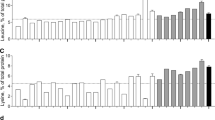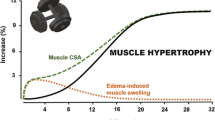Abstract
The functions and geometrical characteristics of a pennate and a parallel-fibered muscle in rats are quantified and compared to each other. The pennate medial gastrocnemius and the more parallel fibered semimembranosus are investigated in fourteen male Wistar rats. The length force diagram, twitch time characteristics and muscle architecture are quantified.
In the parallel fibered semimembranosus the length of the muscle fibres is about 70% of the muscle optimum length (the length at which the muscle performs maximal active force), while in the pennate fibered gastrocnemius the length of the muscle fibres is 36% of the muscle optimum length. The active length force diagrams normalized with respect to the muscle optimum length show considerable differences between semimembranosus and gastrocnemius: The normalized active length force diagram runs from about 71%–129% of the muscle optimum length for the semimembranosus and from about 82–118% for the gastrocnemius. The latter muscle also has a steeper normalized passive length force curve and produces more active tetanic force per gram muscle (877 g/g for gastrocnemius versus 379 g/g for semimembranosus).
No differences between the semimembranosus and gastrocnemius are found with respect to the passive tension at twitch optimum length (38 g/cm2 versus 32 g/cm2), the maximal active tension (1.27 kg/cm2 versus 1.18 kg/cm2) and the twitch contraction time at twitch optimum length (43.8 ms versus 48.4 ms).
It is concluded that several functional characteristics show a linear relationship with the index of architecture, a measure for the muscle architecture, while others (especially time and tension characteristics) are independent of muscle architecture.
Similar content being viewed by others
References
Ariano MA, Armstrong RB, Edgerton VR (1973) Hind limb muscle fibre populations of five mammals. J Histochem Cytochem 21:51–55
Beck O (1921) Die gesamte Kraftkurve des tetanisierten Frosch. Gastrocnemius und ihr physiologisch ausgenutzter Anteil. Pflügers Arch 193:495–526
Binkhorst RA, van't Hof MA (1973) Force-velocity relationship and contraction time of the rat fast plantaris muscle due to compensatory hypertrophy. Pflügers Arch 342:145–158
Blix M (1893–1894) Die Länge und Spannung des Muskels It/m IV. Skan Arch 5
Calow LJ, Alexander RMN (1973) A mechanical analysis of a hind leg of a frog (Rana temporaria). Zoology (Lond) 171:293–321
Close R (1964) Dynamic properties of fast and slow skeletal muscles of the rat during development. Physiol 173:74–95
Close RI (1972) Dynamic properties of mammalian skeletal muscles. Physiol Rev 52:129–197
Gans C, Bock WJ (1965) The functional significance of muscle architecture — a theoretical analysis. Ergeb Anat Entwicklungsgesch 38:115–142
Gollnick PD (1981) Muscular enlargement and number of fibers in skeletal muscles of rats. J Appl Physiol 50:936–943
Gordon AM, Huxley AF, Julian FJ (1966) The variation in isometric tension with sarcomere length in vertebrate muscle fibres. J Physiol 184:170–192
Goslow GE, Cameron WE, Stuart DG (1977) Ankle flexor muscles in the cat: Length-active tension and muscle unit properties as related to locomotion. J Morphol 153:23–38
Hill AV (1953) Mechanics of active muscle. Proc Royal Soc (Lond), Series B, 141:104–117
Ismail HM, Ratanunga KW (1978) Isometric tension development in a human skeletal muscle in relation to its working range of movement: The length-tension relation of biceps brachii muscle. Exper Neurol 62:595–604
Peters GE, Rick C (1977) The actions of three hamstring muscles of the cat: A mechanical analysis. J Morphol 152:315–328
Rack PMH, Westbury DR (1969) The effects of length and stimulus rate on tension in the isometric cat soleus muscle. J Physiol 204:443–460
Ralston HJ, Inman VT, Strait LA, Shaffrath MD (1947) Mechanics of human isolated voluntary muscle. Am J Physiol 151:612–620
Spector GA, Gardiner PF, Zernicke RF, Roy RR, Edgerton VR (1980) Muscle architecture and force velocity characteristics of cat soleus and medial gastrocnemius: Implifications for motor control. J Neurophysiol 44:951–960
Stephens JA, Rainking RM, Stuart DG (1975) The motor units of cat medial gastrocnemius: Electrical and mechanical properties as a function of muscle length. J Morphol 146:495–512
Williams PE, Goldspink G (1978) Changes in sarcomere length and physiological properties in immobilized muscle. J Anat 127:459–468
Author information
Authors and Affiliations
Rights and permissions
About this article
Cite this article
Woittiez, R.D., Huijing, P.A. & Rozendal, R.H. Influence of muscle architecture on the length-force diagram of mammalian muscle. Pflugers Arch. 399, 275–279 (1983). https://doi.org/10.1007/BF00652752
Received:
Accepted:
Issue Date:
DOI: https://doi.org/10.1007/BF00652752




